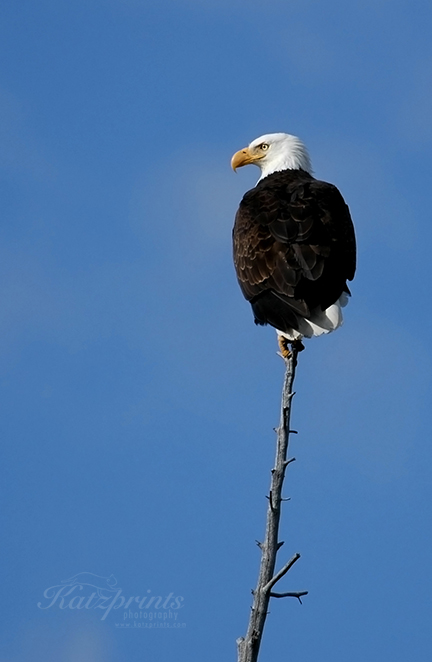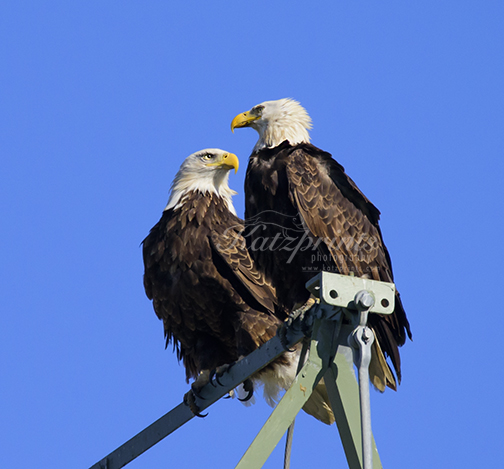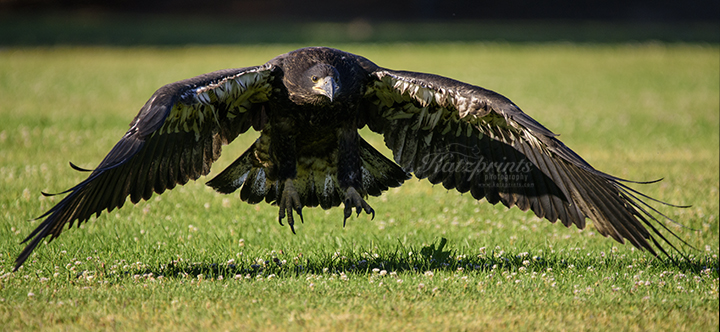For as long as I can remember, my parents and friends have called me “eagle eye”. When some tiny item dropped into the grass or a car key went missing, I was called to the rescue. When a text had to be proofread before publishing, I was the go-to person. After decades of computer work and its associated sight deterioration, my success rate has admittedly gone down … but that’s OK because it got replaced by something much better. Real eagle eyes!
Bald eagles
My very first bald eagle sighting! Ahhh, I can remember it so well. I was visiting Yellowstone National Park with my BF and the beautiful bird sat on top of a dead tree next to the Lake Yellowstone Hotel. Being inseparable from my camera, I took a photo.

And even though my shot was not very good, I was extremely happy to have captured this iconic bird in the wild. A few more encounters followed over the years, one during a drive on the Olympic Peninsula, another during a leaf-peeping trip to Convict Lake in the Eastern Sierra, and one more at the shores of Lake Tahoe.
Special, fleeting moments all, far away from home.
Until 2017.
Historical feather facts
Before we visit the present, let’s first have a quick walk down memory lane. America adopted the bald eagle as its national symbol in 1782, a time when the number of nesting birds was estimated at about 100,000. By 1963, the number of nesting pairs had fallen under 500 rendering the bird close to extinction. What happened in those 180 years?
Three major things:
-Considerable loss of habitat
-Hunting (eagles were shot as perceived livestock killers; unfortunately, this is still happening today)
-DDT
Shortly after World War II, DDT was hailed as a new pesticide to control mosquitoes and other insects. I sometimes wonder if it actually was in the rather efficient mosquito spray my parents used when I was a kid… And as so often happens with new and shiny (chemical) toys, it takes time to figure out their side-effects. In the case of DDT, it silently worked itself through the food chain and ended up in the eagles’ diet (among other places), slowly poisoning the birds and interfering with their ability to produce eggshells thick enough to remain intact during incubation. With hardly any offspring to account for, numbers plummeted.
A combination of key actions – the ban of DDT by the EPA, the enactment of the Endangered Species Act, the Migratory Bird Treaty Act, and the Bald and Golden Eagle Protection Act, as well as the protection of nesting sites and successful breeding programs – brought the eagles back from the brink of extinction in one of the best wildlife conservation success stories of our times. (We’ll talk about some of the other stories in future posts.)
Bay Area eagles
As part of the eagle rebound, we now have bald eagles in Silicon Valley. I know! It’s crazy, isn’t it!? I talked to a ranger last year and he said there might be as many as 20 individuals calling the greater Bay Area their home. I can only take his word for that but what I do know is this: I have been spending uncountable hours with one pair over the last years and it’s been an inspiring and at times dramatic experience!
Now, we do have a code of conduct amongst birders and wildlife photographers not to disclose nesting sites of rare or protected species. However, the eagle pair I will tell you about lives a rather public life. It’s been written about in the print media and has made appearances on local news stations. Hence, I feel comfortable writing this post.
The pair built a nest in Milpitas of all places (actually, thinking about it, not too surprising… after all, who can afford real estate anywhere along the Peninsula these days?!) and had their first chick in 2017. The young parents did well and we saw the chick grow from a little grey fuzzball to a beautiful brown-colored juvenile.
No one knew if the eagle presence was going to be a one-off, so imagine the delight when they came back for more!

In 2018, the pair had two chicks, and while that could be considered a success, it meant much more work and drama. On June 18 of that year, one of the eaglets fell out of the nest. Of course, those of us who have siblings think she probably got pushed, but either way, it was not a good situation. Just think cars, dogs, feral cats, raccoons…
The California Department of Fish & Game and the Milpitas Fire Department came with a cherry picker lift to put the eagle back into the nest after a medical exam. But you know how you pick a flat screen TV in a store and think it’ll be great in your house just to realize later it is actually huge?! Well, the crane and the redwood tree were not a match made in heaven. The rescuers reached nowhere near the nest. All they could do was put the eagle on a lower branch. (OK, kidding aside, it truly is a team effort providing eagles in this urban environment of ours with a fighting chance, and California Fish & Game, Milpitas PD, the City of Milpitas, the Vice Mayor, the Fire Dept, the Wildlife Center of Silicon Valley, have all been great partners! But I digress.)
So Fish & Game put the eagle on a branch. Or should I say they tried? Our eaglet could not hold on, fell right off, and hurt itself further. The good people of the Lindsey Wildlife Rehabilitation Hospital in Walnut Creek tended to its bruises. They also treated it, no, wait, HER (!) for lead exposure, a possible reason for some of her problems. After a few days, via the California Foundation for Birds of Prey, she – by now we called her “Lucky” – was transferred to the Ventana Wildlife Society, the wonderful organization in charge of reintroducing California Condors into the wild. They continued her care and provided a soft release at their condor recovery release site. I found out from Joe Burnett, Senior Biologist at VWS, that she was hanging out with some impromptu role models, California condors, for a few days but we don’t know where her wings took her afterwards. Hopefully, she is now freely roaming the coastal hills or taking dips in Lake Nacimiento. Meanwhile, eaglet #2 couldn’t care less about all the commotion and grew up nicely, using a sports field for flying and landing practice.

This year, the eagle saga continued with a twist. Eagles mate for life but the 2019 dad didn’t look like our prior, disheveled dad. No. He looked good! Did he visit the spa to regrow all the broken tail feathers when the kids were finally out of the house? Unfortunately, it is more likely that he died and momma eagle accepted a new partner. They fortified the nest and started a new family with two chicks again. On a constant stream of fish, occasionally enhanced by squirrels or ducklings, the two little bald eagles grew quickly. By the end of June, both were testing their wings and hopping around in the nest.
A few days before the 4th of July, the bigger eaglet fledged. He probably thought it was a great idea. That is, until he realized he could not get back into the nest. So yet again, drama ensued. The eaglet spent two days on a small tree, calling for food while the parents tried to coax him back to the nest. On July 5, he landed in the school yard prompting Milpitas police to put up police tape in the hope of keeping people and their dogs away from the grounded bird. Problem is, police tape might keep people out but not necessarily eagles in. And so in the afternoon of that day, he limboed right under that tape and into the streets. Normally, it would not occur to me to walk into the street and direct traffic, but desperate times call for desperate measures! And so I stopped a few cars and made sure that our eaglet safely crossed the street. On a crosswalk no less!

Later that day, he tried to fly again and crash landed in an orange tree. From there he managed to hop onto a roof. Where he got attacked by mockingbirds. And got stuck in one of those whirly roof fans. Maybe that’s just nature. Or maybe karma was coming down hard on him for not sharing his food with his younger sibling. Either way, finally, finally, after five days without food, the eaglet made it back into the nest. Up high in the redwood tree, he performed the eagle rendition of The Very Hungry Caterpillar. First, he ate a fish, but he was still hungry. Then he ate a duckling. Then a seagull. You get the idea!
Who knows what the next days and weeks will bring for our bald eagle family, but this much is sure: growing up as an eagle in an urban environment is not easy!!
************************************
I am heartbroken.
News about the younger eaglet, 07/13, PM:
Community,
It is with great sadness that I share that our eaglet, little Jr., was found dead this afternoon. I have been at the scene working with our Police Department, the Department of Fish and Wildlife Law Enforcement, and our community to ensure there is a full investigation to find out the cause of death. Please, if you heard or saw any activity, please report it to Cal Tip at 1-888-334-2258.
We will continue to work together to find out what happened to our beloved feathered community member. We hope to have more information in the next upcoming days. If you have any questions, please feel free in contacting me.
In community,
Karina Dominguez
Vice Mayor, City of Milpitas

************************************
If you were inspired by this story, consider donating to one of the many groups that take care of injured wildlife. I mentioned several close to my heart in this post but there are many more. Also, even though it might be tempting, please do not fly drones near nests (it disturbs the birds and happens to be illegal), make sure to keep your pets away from birds on the ground, and keep your distance from wildlife. 100 yards is always a good recommendation.

